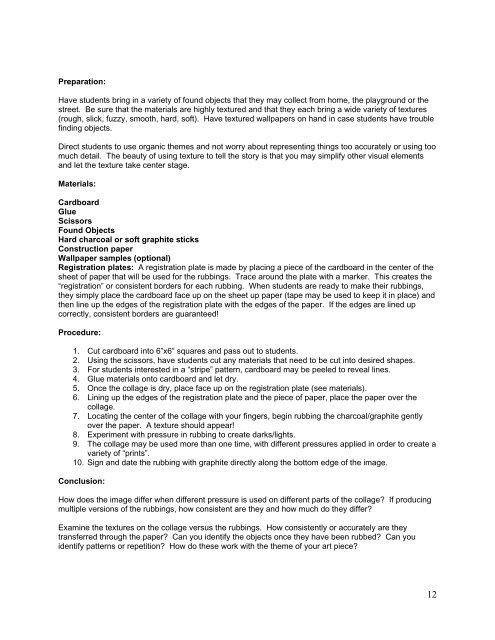Frida Kahlo - Faculty Web Pages
Frida Kahlo - Faculty Web Pages
Frida Kahlo - Faculty Web Pages
Create successful ePaper yourself
Turn your PDF publications into a flip-book with our unique Google optimized e-Paper software.
Preparation:<br />
Have students bring in a variety of found objects that they may collect from home, the playground or the<br />
street. Be sure that the materials are highly textured and that they each bring a wide variety of textures<br />
(rough, slick, fuzzy, smooth, hard, soft). Have textured wallpapers on hand in case students have trouble<br />
finding objects.<br />
Direct students to use organic themes and not worry about representing things too accurately or using too<br />
much detail. The beauty of using texture to tell the story is that you may simplify other visual elements<br />
and let the texture take center stage.<br />
Materials:<br />
Cardboard<br />
Glue<br />
Scissors<br />
Found Objects<br />
Hard charcoal or soft graphite sticks<br />
Construction paper<br />
Wallpaper samples (optional)<br />
Registration plates: A registration plate is made by placing a piece of the cardboard in the center of the<br />
sheet of paper that will be used for the rubbings. Trace around the plate with a marker. This creates the<br />
“registration” or consistent borders for each rubbing. When students are ready to make their rubbings,<br />
they simply place the cardboard face up on the sheet up paper (tape may be used to keep it in place) and<br />
then line up the edges of the registration plate with the edges of the paper. If the edges are lined up<br />
correctly, consistent borders are guaranteed!<br />
Procedure:<br />
1. Cut cardboard into 6”x6” squares and pass out to students.<br />
2. Using the scissors, have students cut any materials that need to be cut into desired shapes.<br />
3. For students interested in a “stripe” pattern, cardboard may be peeled to reveal lines.<br />
4. Glue materials onto cardboard and let dry.<br />
5. Once the collage is dry, place face up on the registration plate (see materials).<br />
6. Lining up the edges of the registration plate and the piece of paper, place the paper over the<br />
collage.<br />
7. Locating the center of the collage with your fingers, begin rubbing the charcoal/graphite gently<br />
over the paper. A texture should appear!<br />
8. Experiment with pressure in rubbing to create darks/lights.<br />
9. The collage may be used more than one time, with different pressures applied in order to create a<br />
variety of “prints”.<br />
10. Sign and date the rubbing with graphite directly along the bottom edge of the image.<br />
Conclusion:<br />
How does the image differ when different pressure is used on different parts of the collage? If producing<br />
multiple versions of the rubbings, how consistent are they and how much do they differ?<br />
Examine the textures on the collage versus the rubbings. How consistently or accurately are they<br />
transferred through the paper? Can you identify the objects once they have been rubbed? Can you<br />
identify patterns or repetition? How do these work with the theme of your art piece?<br />
12


